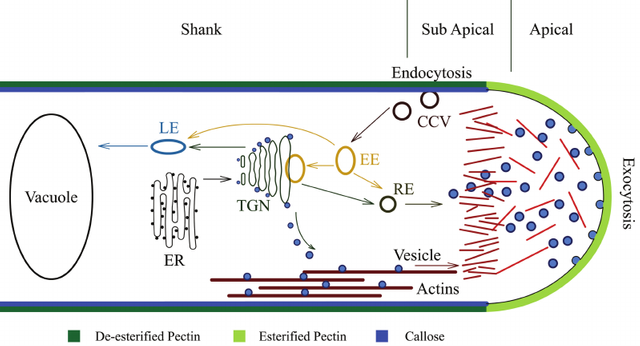Cornichon sorting and regulation of GLR channels underlie pollen tube Ca2+ homeostasis
Calcium currents characterize the developing pollen tube in the small mustard plant Arabidopsis and correlate with growth at the tip of the pollen tube. This system constitutes a practical model for screening for Ca2+-signaling mechanisms in plants.

Wudick et al. analyzed multiple variants of glutamate receptor–like (GLR) channels and discovered that some work alone and others work in pairs or trios. Subcellular localization of GLRs is a complex response to CORNICHON sorting proteins, which leave some GLRs at the plasma membrane and ferry others to internal calcium reservoirs. The calcium current at the tip of the growing pollen tube apparently integrates multiple intracellular currents.

Compared to animals, evolution of plant calcium (Ca2+) physiology has led to a loss of proteins for influx and small ligand–operated control of cytosolic Ca2+, leaving many Ca2+ mechanisms unaccounted for. Here, we show a mechanism for sorting and activation of glutamate receptor–like channels (GLRs) by CORNICHON HOMOLOG (CNIH) proteins. Single mutants of pollen-expressed Arabidopsis thaliana GLRs (AtGLRs) showed growth and Ca2+ flux phenotypes expected for plasma membrane Ca2+ channels. However, higher-order mutants of AtGLR3.3 revealed phenotypes contradicting this assumption. These discrepancies could be explained by subcellular AtGLR localization, and we explored the implication of AtCNIHs in this sorting. We found that AtGLRs interact with AtCNIH pairs, yielding specific intracellular localizations. AtCNIHs further trigger AtGLR activity in mammalian cells without any ligand. These results reveal a regulatory mechanism underlying Ca2+ homeostasis by sorting and activation of AtGLRs by AtCNIHs.
Credit: Science
http://science.sciencemag.org/content/360/6388/533
http://www.sciencemag.org/about/science-licenses-journal-article-reuse
Science 04 May 2018:
Vol. 360, Issue 6388, pp. 533-536